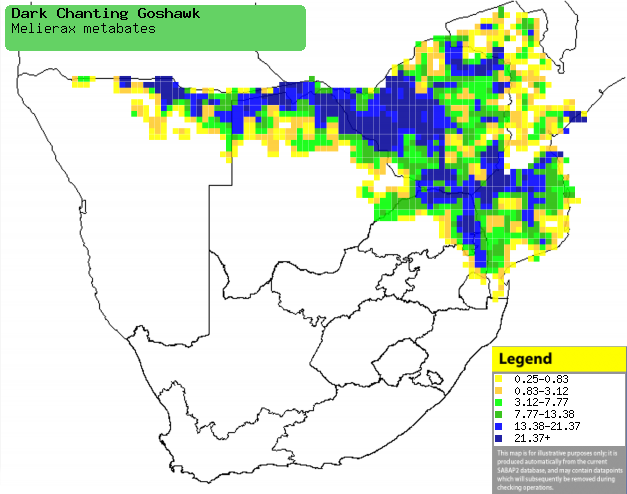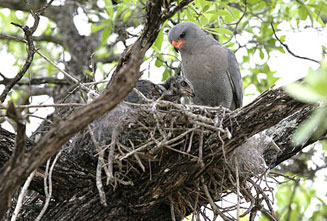|
Melierax metabates (Dark
chanting goshawk)
Donkersingvalk [Afrikaans]; Kakodi (generic term for
sparrowhawks, goshawks, kestrels and falcons) [Kwangali]; donkere
zanghavik [Dutch]; Autour sombre [French]; Graubürzel-singhabicht,
Dunkler grauflügelhabicht [German]; Açor-cantor-escuro [Portuguese]
Life
> Eukaryotes >
Opisthokonta
> Metazoa (animals) >
Bilateria >
Deuterostomia > Chordata >
Craniata > Vertebrata (vertebrates) > Gnathostomata (jawed
vertebrates) > Teleostomi (teleost fish) > Osteichthyes (bony fish) > Class:
Sarcopterygii (lobe-finned
fish) > Stegocephalia (terrestrial
vertebrates) > Tetrapoda
(four-legged vertebrates) > Reptiliomorpha > Amniota >
Reptilia (reptiles) >
Romeriida > Diapsida > Archosauromorpha > Archosauria >
Dinosauria
(dinosaurs) > Saurischia > Theropoda (bipedal predatory dinosaurs) >
Coelurosauria > Maniraptora > Aves
(birds) > Order: Falconiformes
> Family: Accipitridae
> Genus: Melierax
Distribution and habitat
Occupies much of sub-Saharan Africa, excluding the lowland
equatorial forest of the DRC and West Africa. In southern Africa, it is scarce to locally common
in north-eastern Namibia (including the Caprivi Strip), northern Botswana,
Zimbabwe, Mozambique and north-eastern South Africa. It generally prefers tall,
well-developed broad-leaved woodland, especially with miombo (Brachystegia),
Mopane (Colosphermum mopane), Zambezi teak (Baikiaea plurijuga),
Knob thorn (Acacia nigrescens) and Marula (Sclerocarya birrea).
|
 |
|
Distribution of Dark chanting goshawk in southern Africa,
based on statistical smoothing of the records from first SA Bird Atlas
Project (©
Animal Demography unit, University of
Cape Town; smoothing by Birgit Erni and Francesca Little). Colours range
from dark blue (most common) through to yellow (least common).
See here for the latest distribution
from the SABAP2. |
Movements and migrations
Largely resident and sedentary, although it is partially nomadic in the dry season.
Food
It eats a wide variety of animals, especially mammals,
birds and reptiles; it typically hunts from a perch, from which it descends to
catch prey on the ground or in the air. It may follow
Honey badgers (Mellivora capensis),
Southern ground-hornbills,
dogs or humans, catching the prey they disturb. The following food items have been recorded
in its diet:
- Vertebrates
- mammals
- birds
- reptiles
- fish
- carrion
- Invertebrates
Breeding
- Monogamous, territorial solitary nester. Both sexes perform a courtship display, in
which the male repeatedly dives at the female, who presents her claws.
- Both sexes build the nest, which consists of a
saucer-shaped platform of sticks, decorated with spider web and sometimes
cemented with mud. The interior is lined with a variety of
materials, including stones, mud rags, skin, dung, hair, birds nests, bark, seed pods and grass.
The nest is typically
placed in a tree, such as Mopane (Colosphermum mopane), Knob thorn (Acacia
nigrescens), Marula (Sclerocarya birrea) or Mufuti (Brachystegia
boehmii).
 |
|
|
Dark chanting goshawk at its nest with chick,
Pretoriuskop area, Kruger National Park, South Africa,. [photo Warwick Tarboton ©] |
|
- Egg-laying season is from July-November, peaking from August-October.
- It lays 1-2, rarely 3 eggs, which are mainly incubated by the female for
about 36-38 days, while the male regularly feeds her at the nest.
- At first, the chicks are cared for by the female, while the male provides
them all with food. The young leave the nest at about 50 days old, becoming fully independent roughly 3-8 months later.
They disperse
from their parents territory at the beginning of the following breeding
season,
Threats
Not threatened, although it has been negatively affected by
habitat destruction and persecution.
References
-
Hockey PAR, Dean WRJ and Ryan PG 2005. Roberts
- Birds of southern Africa, VIIth ed. The Trustees of the John Voelcker
Bird Book Fund, Cape Town.
|
